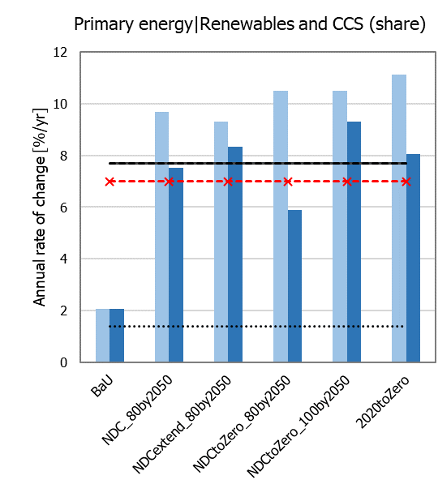Information of Paper
Authors: Diego SILVA HERRAN, Shinichiro FUJIMORI
Year:2021
Journal:Sustainability Science, 489-501
Keywords
Enhanced mitigation ambition, Mitigation scenario, Long-term Strategy, Japan, Computable general equilibrium
Abstract
This paper assesses the energy and macroeconomic impacts of enhancing the ambitions for 2040 and 2050 emission reduction targets in Japan via a computable general equilibrium (CGE) model. The contents highlight the conditions in the 2040s, including emissions levels, energy systems, and macroeconomic responses. These are likely to be discussed intensively in the near future given the post-NDC debate. Results show that, compared to the linear interpolation of the current long-term goal (a 53% reduction in emissions compared to 2005 levels by 2040), enhancing the goals of the 2040 and 2050 targets (a 63% reduction compared to 2005 levels by 2040 and zero emissions by 2050) increase the share of energy from low-carbon sources more markedly than the decreases in energy intensity, and that this increases macroeconomic costs by 19–72%. This paper contributes significantly to enhance forthcoming climate policy debates and the next cycle of the Global Stocktake under the Paris Agreement.



Background of the paper:Stanford Energy Modeling Forum 35 Japan Model Intercomparison Project
This paper is part of a special feature (special issue) “Energy Scenarios for Long-Term Climate Change Mitigation in Japan”, which describes energy scenarios in Japan mainly from the Stanford Energy Modeling Forum (EMF) 35 Japan Model Intercomparison Project (JMIP).
Link to the issue
This project is a multi-model scenario analysis on Japan’s nationally determined contribution (NDC) and long-term strategy in light of a range of uncertainties. Although the scenario design includes full decarbonization, our central scenarios focus on an 80% reduction in emissions by 2050 because our project ran from April 2017 until March 2020, which was before the net-zero pledge by the Japanese government in October 2020. Apart from the papers by each model contributing to the EMF35 JMIP, the special feature contains one main paper that lays out the scenario design (Sugiyama et al. 2021) and three cross-cutting papers that address essential issues for long-term mitigation in Japan: the expansion of renewables (Shiraki et al. 2021), electrification (Sakamoto et al. 2021), and industrial decarbonization (Ju et al. 2021).
Silva Herran, in collaboration with Fujimori, contributed to this special issue with the data and analysis of scenarios using the AIM/Hub-Japan model. In addition, Silva Herran contributed to the design and development of a visualization tool (mipplot) for analyzing the data provided by models participating in the project related to the special issue (EMF35 JMIP).
Related articles
-
EMF 35 JMIP study for Japan’s long-term climate and energy policy: scenario designs and key findings
Authors:Masahiro SUGIYAMA、Shinichiro FUJIMORI、Kenichi WADA、Ken OSHIRO、 Etsushi KATO、Ryoichi KOMIYAMA、Diego SILVA HERRAN、Yuhji MATSUO、Hiroto SHIRAKI、Yiyi JU
This paper identified common patterns for mitigation across different models and scenario settings within the EMF35 JMIP: economy-wide improvements in energy efficiency, the decarbonization of electricity, and end-use electrification. The models also suggest that heavy industries will be one of the hardest to decarbonize in the absence of structural changes in the economy. Furthermore, the models reveal that future policy must be substantially enhanced, compared to the strength and breadth of current policy, to achieve the goal of an 80% reduction in emissions.
-
Industrial Decarbonization Under Japan’s National Mitigation Scenarios: A Multi-Model Analysis
Authors: Yiyi JU、Masahiro SUGIYAMA、Etsushi KATO、Yuhji MATSUO、Ken OSHIRO、Diego SILVA HERRAN
Industry has a higher share of final energy or emissions in Japan than in the United States or Europe. Many material production processes in the industrial sector are not suitable for electrification and there are no easy solutions to this issue. Ju et al. showed that carbon capture and storage (CCS) and hydrogen are key to deep decarbonization, particularly in steelmaking. The outcomes also revealed that more technologies in the early stages of development should be incorporated in current models, particularly in terms of assessing the net-zero target.
-
The role of renewables in the Japanese power sector: implications from the EMF35 JMIP
Authors:Hiroto SHIRAKI、Masahiro SUGIYAMA、Yuhji MATSUO、Ryoichi KOMIYAMA、 Shinichiro FUJIMORI、Etsushi KATO、Ken OSHIRO、Diego SILVA HERRAN
Shiraki et al. elucidated the role of renewables for deep mitigation of emissions from the power sector. Unless nuclear or biomass energy is made widely available, variable renewables will expand greatly, with a median share of 52% under mitigation scenarios. They found that halving the capital costs of renewables could lower policy costs by 8.7% (inter-model median). As the current capital cost of solar PVs in Japan is twice the international standard, reducing this gap in costs can realize cost-effective emissions mitigation in the power sector.
-
Demand-side decarbonization and electrification: EMF 35 JMIP study
Authors:Shogo SAKAMOTO、Yu NAGAI、Masahiro SUGIYAMA、Shinichiro FUJIMORI、 Etsushi KATO、Ryoichi KOMIYAMA、Ken OSHIRO、Yuhji MATSUO、Diego SILVA HERRAN
Sakamoto et al. (2021) considered the demand side and analyzed the role of end-use electrification, which both analysts and policymakers recognize as an important strategy for long-term decarbonization. For an 80% emission reduction target by 2050, electrification rates in the models increased to 37–66% in 2050, up from 26% in 2010. The upward trend in electrification is robust in spite of changes in different scenarios, and tightening the stringency of the emissions constraint further increases electrification. The historical pace of electrification (0.30% point/yr) needs to increase from 2030 to 2050 (0.46%/yr to 1.58%/yr) to achieve deep decarbonization.
-
An open-source tool for visualization of climate mitigation scenarios: mipplot
Authors: Yiyi JU、Masahiro SUGIYAMA、Diego SILVA HERRAN、Jiayang WANG、Akimitsu INOUESynthesizing and communicating knowledge on climate change to policymakers and stakeholders is often difficult due to the complexity and diversity of underlying research. As a “translation” instrument, this paper presents the mipplot tool, an open-source R package that can be used to visualize data of long-term climate mitigation scenarios.




